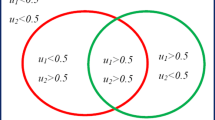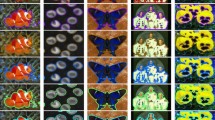Abstract
A new adaptive region-based image fusion approach is proposed. To implement image segmentation, the piecewise smooth Mumford-Shah segmentation algorithm is studied and a fast and simple method is proposed to solve the energy function. Two complementary functions u + and u − of the algorithm, which are respectively looked as objects and background of the image, are extended into the whole image domain, and they are computed by linear or nonlinear diffusion. The key to the algorithm is to make optimal fusion decisions for every segmented region. For this purpose, an evaluation approach has to be given to measure the performances of the available fusion rules. Therefore an energy-based evaluation model, derived from the Total Variation principle, is proposed. By numerical experiment it has been demonstrated that despite an increase in complexity, the new approach has shown a number of advantages over previous ones, for example the ability to preserve all relevant information and remove some of side effects such as reducing contrast and sensitive to error of registration.
Similar content being viewed by others
Abbreviations
- u :
-
the observed image
- u + :
-
the object regions of an image
- u − :
-
the background regions of an image
- u 0 :
-
an input image
- R 2 :
-
2D real domains
- \({\left| {\nabla u} \right|}\) :
-
gradient of the image u
- \({\left| {\nabla u^{+}} \right|}\) :
-
gradient of the image u +
- \({\left| {\nabla u^{-}} \right|}\) :
-
gradient of the image u −
- \({\wp}\) :
-
a bounded open subset in 2-dimensional real domains
- ω:
-
an open curve set
- Γ:
-
boundary curves
- \(\phi\) :
-
level set curves
- ∂ω:
-
zero level set curves in 2D space
- \(\phi _{0}\) :
-
zero level set curves in 3D space
- d :
-
distance between point and zero level set
- E TV :
-
energy of the region of an image from TV model
- E MTV :
-
energy of the fused region of an image from the fusion evaluation model
- F :
-
speed of evolution of curves
- \(\delta (\phi)\) :
-
delta function in Chan–Vese–Mumford–Shah model
- u s :
-
a smooth component of the observed image u 0
- s :
-
scale level
- \( \tilde{u}_{{\rm s}}\) :
-
resulting image obtained from u s by the four-point averaging method
- Ω:
-
segmented regions of an image
- u R :
-
a reference image with the least value for each pixel point
- λ:
-
a positive parameter to control the fidelity in the energy formulation
- μ:
-
a positive parameter to control the fidelity in the energy formulation
- k :
-
iteration numbers
References
Liu J.G. (2000). Smoothing filter-based modulation: a spectral preserve image fusion technique for improving spatial details. Int. J. Remote Sens. 21(18): 3461–3472
Mouat D.A., Mahin G.G. and Lancaster J. (1993). Remote sensing techniques in the analysis of change detection. Geocarto Int. 2: 39–50
Mallat S. (1998). A wavelet tour of signal processing. Academic, London
Claypoole R.L., Davis G.M. and Baraniuk R.G. (2003). Nonlinear wavelet transforms for image coding via lifting. IEEE Trans. Image Process. 12(2): 1449–1459
Klein L. (1999). Sensor and data fusion concepts and applications. SPIE, Bellingham
Lewis, J.J., O’Callaghan, R.J., et al.: Region-based image fusion using complex wavelets. Proceedings of the 7th International Conference on Information Fusion, Stockholm, pp. 555–562, (2004)
Yang, J., Blum, R.S.: A region-based image fusion method using the expectation-maximization algorithm. Proceedings of the Conference on Information Sciences and Systems (CISS), Princeton (2006)
Petrovic V.S. and Xydeas C.S. (2003). Sensor noise effects on signal-level image fusion performance. Inf. Fusion 4: 167–183
Weickert, J.: A review of nonlinear diffusion filtering. Scale space theory in computer vision, LNCS 1252. Springer, Berlin, pp. 3–28 (1997)
You Y. and Xu W. (1996). A. Tannenbaum, M. Kaveh, Behavioral analysis of anisotropic diffusion in image processing. IEEE Trans. Image Process 5(11): 1539–1553
Rudin L., Osher S. and Fatemi E. (1992). Nonlinear total variation based noise removal algorithms. Physica 60: 259–268
Chan T.F. and Vese L.A. (2001). Active contours without edges. IEEE Trans. Image Process. 10(2): 266–277
Chan, T.F., Vese, L.A.: A level set algorithm for minimizing the Mumford–Shah functional in image processing. In: Proceedings of the First IEEE Workshop on Variational and Level Set Methods in Computer Vision, pp. 161–168 (2001)
Mumford D. and Shah J. (1989). Optimal approximations by piecewise smooth functions and associated variational problems. Comm. Pure Appl. Math. 42(5): 577–685
Zhang, Z., Blum, R.: Region-based image fusion scheme for concealed weapon detection. In: Proceedings of the 31st Annual Conference on Information Sciences and Systems pp. 168–173 (1997)
Piella, G.: A region-based multi-resolution image fusion algorithm. In: ISIF Fusion conference, Annapolis, USA, pp. 1557–1564 (2002)
Kim, S., Lim, H.: Method of background subtraction for medical image segmentation. In: Proceedings of the 3rd International Conference on Cybernetics and Information Technologies, Systems and Applications, pp. 87–91 (2006)
Zhang, Y.J., Ge, L.L.: Automatic generation of initial contour for image segmentation approaches using curve evolving. Electron Lett Comput Vis Image Anal (Accepted and to appear)
Perona P. and Malik J. (1990). Scale-space and edge detection using anisotropic diffusion. IEEE Trans Pattern Anal Mach Intell 12(7): 629–639
Author information
Authors and Affiliations
Corresponding author
Rights and permissions
About this article
Cite this article
Zhang, Y. Adaptive region-based image fusion using energy evaluation model for fusion decision. SIViP 1, 215–223 (2007). https://doi.org/10.1007/s11760-007-0015-6
Received:
Revised:
Accepted:
Published:
Issue Date:
DOI: https://doi.org/10.1007/s11760-007-0015-6




